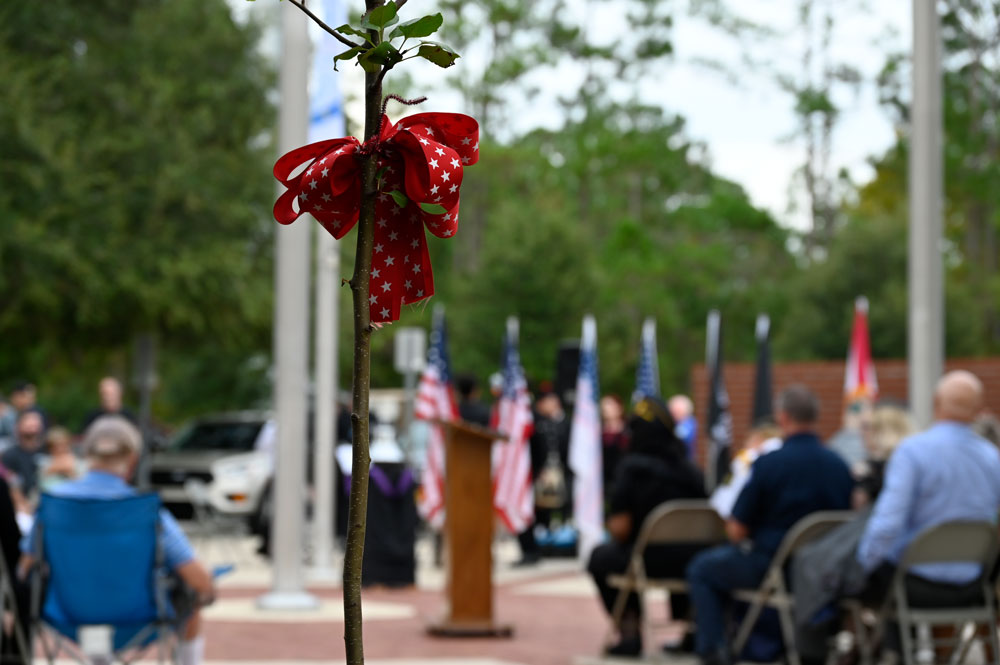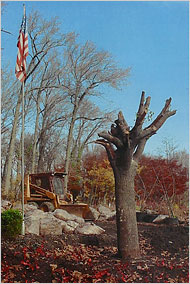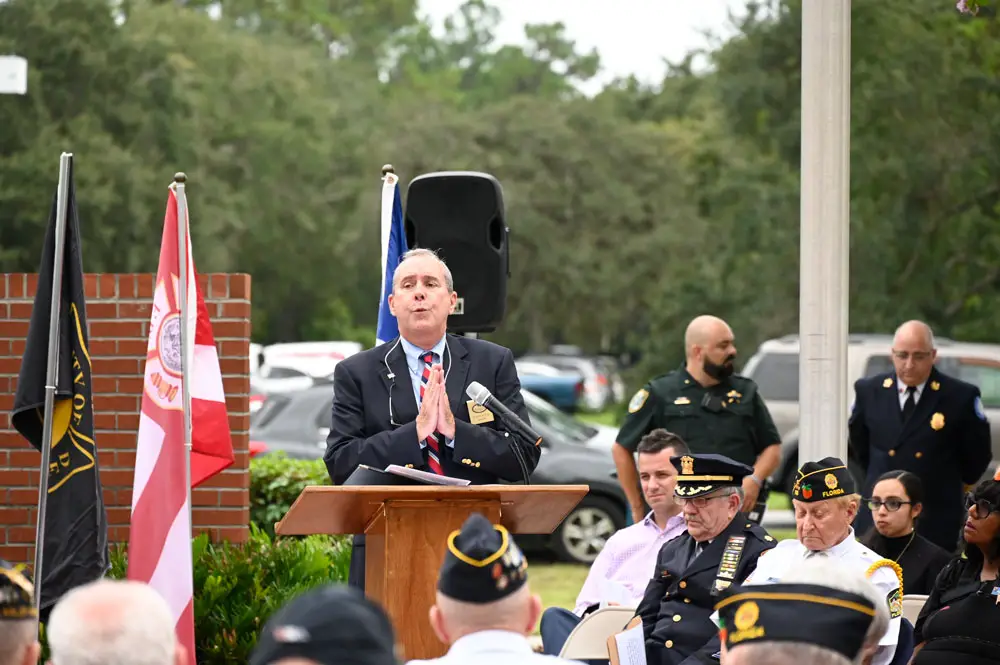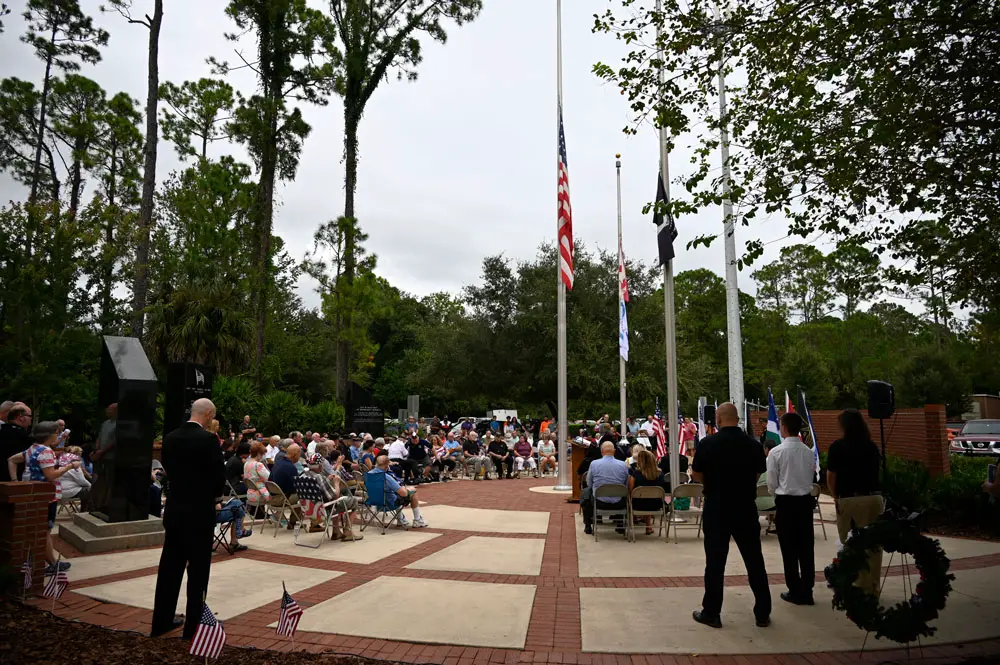
Like Palm Coast’s live oaks, New York City has a favored tree for its sidewalks and plazas, home to 600,000 trees: the Bradford Callery pear . Like so much else that has made the city, it’s an immigrant, originating in China and Vietnam and rooting its way to the East Coast in Model T days.
It grows fast and tall, its branches rising in the shape of a bell well above street level. It is resilient, resistant to disease and a gentle contrast to its urban surroundings, its picturesque buzz of blossoms tolling off-white in spring, its gloss of foliage shining through fuming buses and commuters in fall, and lending its immediate surroundings a shade of peace from the racing rats below.
The trees usually have a life-span of a century, less in New York, where they’re exposed to streets’ exuberant pollution. Innumerable Callery pears were planted in the plaza of the World Trade Center and around it. They were all smashed, including one particular tree on Church Street. It wasn’t disinterred from rubble until six weeks after the 9/11 attacks, as city Parks and Recreation Department experts had been assigned to find any surviving flora around Ground Zero. What was left of it was about 8 feet tall, its branches shredded, its stature as if decapitated. “It was what we would consider mortally wounded,” Robert Zappala, a former manager in the city’s parks and recreation department, said in a New York Times documentary.

Then came another disaster. In mid-March 2010, a severe storm uprooted it and shoved it almost flat on its side. There were fears it would, again, not survive. But it did.
Nine months later it was uprooted again, this time for its final journey back to Ground Zero, to take its place–an honored place really, where mythology rustles reality–alongside the 400 swamp white oak and sweetgum trees that anchor the landscaping of the National September 11 Memorial plaza , where the Twin Towers once stood.
And like a Shel Silverstein classic, it hasn’t stopped giving since.
Saturday evening in Palm Coast, in a 9/11 memorial ceremony organized by Patrick Juliano and the Palm Coast Fire Department, a sapling from the Survivor Tree was dedicated at Heroes Park, at the edge of the park’s central ellipse. Palm Coast had become part of the Survivor Tree Seedling Program.
“If you visit the site today, you’ll feel the hope it spreads as it thrives in the shadow of the museum,” Mayor David Alfin said as he briefly retraced the rings of the trees’ life through deaths and rebirth at the memorial site. “Thanks to a donation from our friends at the St. Augustine Fire Department, we are dedicating a seedling from the callery pear survivor tree here tonight, a living reminder of resilience, survival and rebirth. Its growth will remind us of how wounds heal and how beauty can replace ugliness. We’ve learned that the planting of a tree is a most fitting way to teach younger generations about the circle of life. Like a tree, we experienced the change of seasons of our lives, from the joyous to the saddest occasions, even when we experienced the darkest days in our lives.”
Every year since 2013, the Survivor Tree Seedling Program has distributed three seedlings to communities that experienced a particular trauma, natural or hate-made. In 2013, Far Rockaway, Queens, was among the first recipients after its battering by Superstorm Sandy. Prescott, Arizona, got a seedling to honor the 19 firefighters who died on June 30, 2013, fighting fires, in the single-largest loss of life for firefighters since 9/11.
But the program is as much generosity in redemption as it is a reminder of man’s unceasing inhumanity to man. Boston got a seedling after the murder of three people in the April 15, 2013 bombing at the city’s marathon. Other cities and communities have included Killeen, Texas, site of two mass shootings, Madrid, in memory of the 2004 bombings there that killed 190 people, Newtown, site of the massacre of 20 children at the hands of a mass shooter, Paris after the islamist attacks of 2015 and 2016 that killed 225 people, Orlando after the mass murders at the Pulse night club, Parkland, Las Vegas, Christchurch, New Zealand: it is a list as grim as that of those who died on 9/11. Like the tree, the list is still growing.
According to Juliano, the St. Augustine Fire Department picked up six seedlings from Queens, N.Y., with the understanding that it would find six sister cities to share them with. “We wanted to help departments in the area celebrate 9/11,” Carlos Aviles, the St. Augustine fire chief, told Juliano, “so we shared the grant application and served as a single point of contact. We figured it would be easier for us to manage the grant as well as serve as the agency that would facilitate transporting the trees back to Florida.”
The seedlings are identified by their own unique medallions. Palm Coast’s branch of the Survivor Tree is #725.
“I loved having this opportunity,” Juliano said. “It embodies the message of hope and life after death.” Like all Juliano productions, the ceremony at Heroes Park Saturday evening, straddling the light and dark of the the hour, reflected in speeches, ritual and music the message he intended. The voices were as ecumenical as they were cross-generational. A running theme of the evening was the importance of memory and passing on the meaning of the day on an anniversary that marked the closing of a full generation and the beginning of another since the attacks: Juliano had invited students from Matanzas High School and the Flagler Youth Orchestra (well representing Flagler Palm Coast High) to perform–the Star Spangled Banner, “America the Beautiful,” “Let There Be Peace on Earth.”
“It just gets really difficult for me,” said Major Ronald Young, a retired member of the New York Court Police who put in days and nights on the Pile at Ground Zero and one of the evening’s speakers. “Twenty years have gone by. Forget about 20 years. Let’s talk about one generation of Americans. Pretty damn scary. Really, looking back, this is very painful. However, it is it also a moment of our collective history that should never be forgotten as we all strive to move forward with gratitude, purpose and hope.”
The speakers also featured Ophelia Beier, who described escaping out of the blackened corridors of the Pentagon in the minutes after the attack there (“I have rose from the ashes”), Deputy Fire Chief Bradd Clark, who was the master of ceremonies, and Fire Chief Jerry Forte, who described how he found out that the flag was missing from the pole at Palm Coast Parkway and Old Kings Road. He put up his own father’s flag. “So as you’re going home eastbound tonight you’ll look up that flagpole–my dad’s flag,” he said. Quoting his father, “he would have said, put up that damn flag.”
He intended the story as a parable: “Why it’s so important for us to carry on. Why, why we have such extraordinary people that just do things, and they didn’t question it. They just did it because it was the right thing to do.”
But the speakers were really second fiddle to the star of the ceremony, modest as it looked and overlooked as it seemed for much of the ceremony as words cast about over memories and the grasp for meaning: old hat for a tree that always proves mightier than rubble, neglect and grandiloquence.
The evening dedication ended with Juliano on his melancholy bagpipes as he walked before and past the audience of scores, his sounds disappearing behind the older trees and brush dwarfing Survivor Tree Sapling #725.
![]()
































Land of no turn signals says says
How long before we wipe this part of history from the books and the 9/11 memorial to be removed because it is found to be offensive?
YankeeExPat says
Darkness cannot drive out darkness; only light can do that. Hate cannot drive out hate; only love can do that.
Martin Luther King, Jr.
Leila says
Hope… We’ll take it.
Whathehck? says
This was a dignified ceremony and we can be proud of our Fire Department for it. It was very emotional especially so when the survivors told their story. Many of the speakers told about hope.
That day and the days, months and years following this inhumane attack on our Country brought out the best of the American spirit and unity, we were one USA.
The young people, born after the attack, in the audience were solemn and respectful. The Youth Orchestra, the young singer from Matanza HS and Mrs. Robinson added elegance to this ceremony. Yes this was a day of reflection but also of hope.
RitaMae says
Beautiful ceremony. Thank you Lieutenant Patrick Juliano for your dedication.
Whathehck? says
Hope! Yet I witness the atrocious attitude of one Flagler County commissioner. He was playing with his cell phone during the testimony of survivors. At one point he played out loud a “funny” video, he then shared the video with the companion of another County Commissioner and all three had a good laugh. This horrific attitude squashed the hope that the ceremony conveyed.
What happened to the decent America of yore?